Electrically Controlled Contactors, DOL Starters, Auxiliary Contacts, Thermal Overloads

Using switching devices can be a great way to control your electrical system. It can help prevent overloads and arcing. It can also help you save money.
Electrically controlled switching devices
Depending on the application of electrically controlled switching devices, contactors, DOL Starters, Auxiliary Contacts, Thermal Overloads may be used to control an electric current, electromagnetic radiation, fluid stream, or data. Electrically controlled switching devices may have a fixed or movable contact configuration, a field-effect solid-state element, or a combination of the two.
An electrically controlled switching device comprises an insulating frame, two support plates, a dielectric body, and a movable member. The movable member may be either a flexing reed or an electric wafer. The movable member may be positioned either in an upper or lower position, between the support plates. In order to maintain the position of the movable member conductive pads are arranged on the support plates. These conductive pads may form a matrix arrangement with a gap between each pair of conductive pads.
Common uses
Essentially contactors are electrically operated devices, which break or make a connection between a load and the power supply. In most cases, contactors are used to control electric motors. But they can also be used in a variety of other applications. They are used to turn loads on and off repeatedly, and they can be used to switch capacitors.
Most contactors have multiple contacts. These contacts are classified as power contacts, auxiliary contacts, or a combination of both. These contacts are usually either normally open or normally closed, but some contactors are designed with bifurcated contacts. This design minimizes the contact bounce, which results in less wear and tear.
Contactors also typically include magnetic arc suppression. This is done by extending the path of the arc. This is done by a coil or electromagnet, which produces an attractive force when crossed by electric current.
Arcing
Generally, switching devices like Contactors, DOL Starters, Auxiliary Contacts, Thermal Overloads are used in controlling electrical circuits. They are used in a variety of applications from lighting to thermal evaporators to capacitor banks. They can handle a large range of currents, including 5000 amperes to over 100 kilowatts. They are also available in a wide variety of sizes.
Some of these devices are made specifically to handle high voltages. Others are designed for AC voltages. Magnetic contactors are the most common types. They use an electromagnet to generate a strong magnetic field that extinguishes an arc. These are safer and more energy-efficient to operate than their electromechanical counterparts.
Gas-filled contactors are also available. These are limited to unidirectional current flow, but they have less short-circuit ratings than their counterparts. They also cool the arc, which helps reduce its duration.
Overloads
Often used in combination with , overloads on contactors are electrical devices that help protect motors from overloads. In the event that a motor is subjected to excessive current, the overload relay opens the circuit to interrupt the flow of current. This prevents the motor from overheating and allows it to be restarted once the circuit has cooled.
Overloads on contactors can be either thermal or magnetic. Thermal overload relays work by detecting excessive current and interrupting the circuit. Unlike magnetic overload relays, thermal overloads are not responsive to the ambient temperature.
Thermal overload relays are generally arranged in series with the motor. The thermal overload relay has two auxiliary contacts. The auxiliary contacts are opened when the tripping mechanism is activated.
Bimetallic overload relays are often arranged in a motor circuit to automatically reset the circuit. The overload relay contains a winding heater and a eutectic alloy tube. These devices melt when they are exposed to heat. The strip heats up and bends, causing the normally closed electrical contacts to open. The strip then cools down, allowing the tripping mechanism to close.
Safety features
Generally, Contactors, DOL Starters, Auxiliary Contacts, Thermal Overloads are using to switch electric circuits on or off. The most important component of a contactor is the coil or electromagnet. When current flows through the contactor, the electromagnet produces a magnetic field. The field then moves the armature, which opens and closes the contacts. This allows current to pass through the contacts and to the load.
Contactors are most commonly used to switch high-current loads, such as electric motors. They can handle voltages from 25VDC to thousands of volts. In addition, they provide isolation from high electric currents. They are packaged in tough housings to protect the contacts from dust, oil, and other environmental hazards.
Contactors are available in a variety of sizes and shapes. They are also available in safety versions that are designed specifically for safety applications.
Best Selling Products
Reccent Posts
- Finding Appropriate LED Downlights: A Comprehensive Approach
- A Versatile Product Range of LED Lights by AGM Electrical Supplies
- How Cable Clips Help in Organizing Cables?
- The Most Entrusted Electrician Supply Store in Australia
- Electrically Controlled Contactors, DOL Starters, Auxiliary Contacts, Thermal Overloads











